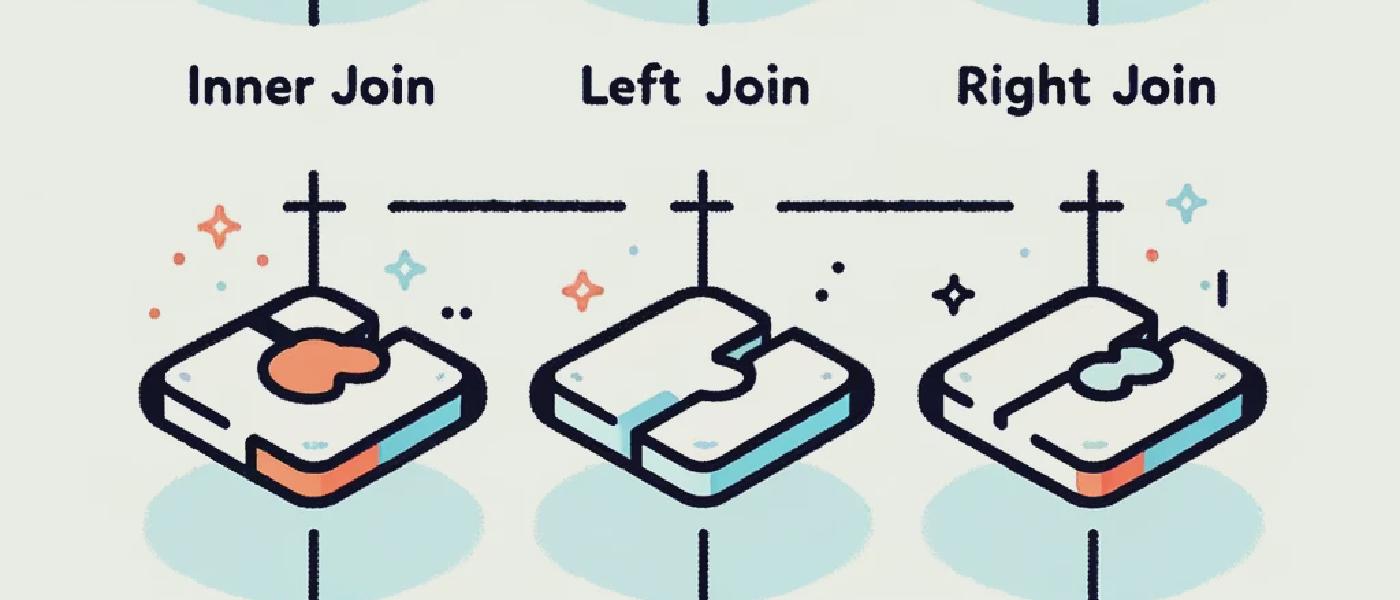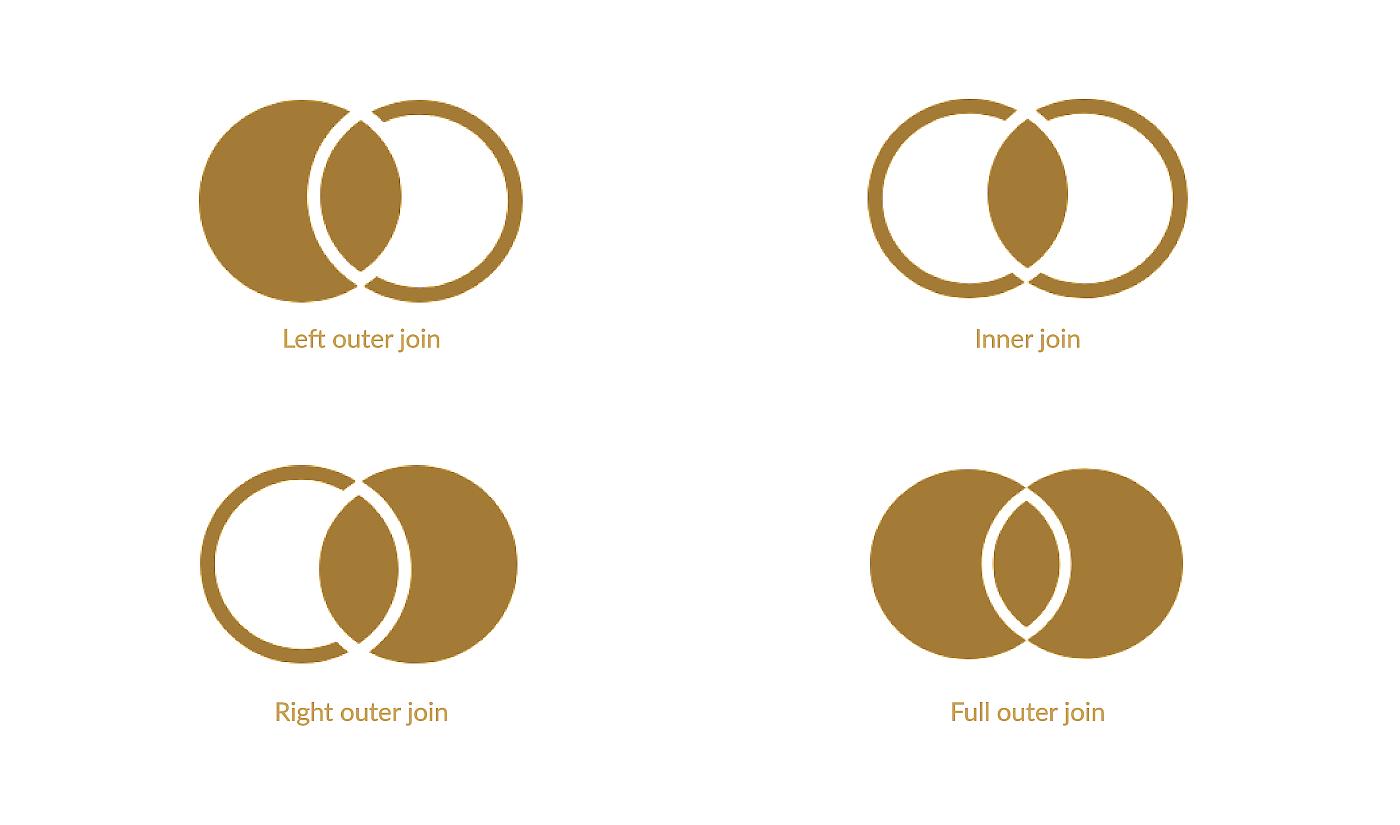Blog
Understanding SQL Joins with Real-World Examples
Posted on May 31, 2024 (Last modified on June 1, 2024) • 6 min read • 1,274 wordsLearn about different types of SQL joins with practical examples and real-world use cases. This guide covers INNER JOIN, LEFT JOIN, RIGHT JOIN, FULL JOIN, and CROSS JOIN with detailed explanations.

Introduction
SQL joins are a crucial part of relational database management, enabling the combination of data from multiple tables based on related columns. Understanding different types of joins is essential for efficient data querying and manipulation. This guide will walk you through various SQL joins with practical examples and real-world use cases, including INNER JOIN, LEFT JOIN, RIGHT JOIN, FULL JOIN, and CROSS JOIN.
Sample Dataset
We’ll use the following sample data for all the examples:
Customers
| CustomerID | CustomerName |
|---|---|
| 1 | Alice |
| 2 | Bob |
| 3 | Charlie |
| 4 | Dave |
Orders
| OrderID | CustomerID | OrderDate |
|---|---|---|
| 101 | 1 | 2023-05-01 |
| 102 | 2 | 2023-05-02 |
| 103 | 3 | 2023-05-03 |
| 104 | 5 | 2023-05-04 |
Products
| ProductID | ProductName |
|---|---|
| 1 | Laptop |
| 2 | Tablet |
| 3 | Smartphone |
Stores
| StoreID | StoreName |
|---|---|
| 1 | Store A |
| 2 | Store B |
Types of Joins
1. INNER JOIN
Definition: Returns records that have matching values in both tables. Useful for combining related data from two tables.
Example Query:
SELECT Customers.CustomerName, Orders.OrderID, Orders.OrderDate
FROM Customers
INNER JOIN Orders ON Customers.CustomerID = Orders.CustomerID;Result:
| CustomerName | OrderID | OrderDate |
|---|---|---|
| Alice | 101 | 2023-05-01 |
| Bob | 102 | 2023-05-02 |
| Charlie | 103 | 2023-05-03 |
Explanation and Usefulness:
- This join retrieves customers who have placed orders.
- Use Case 1: Generating reports that show which customers have made purchases.
- Use Case 2: Identifying active customers for customer relationship management.
- Use Case 3: Determining customer purchase patterns for sales analysis.
2. LEFT JOIN (or LEFT OUTER JOIN)
Definition: Returns all records from the left table (Customers), along with matching records from the right table (Orders). If there is no match, the result will contain NULL values for columns from the right table.
Example Query:
SELECT Customers.CustomerName, Orders.OrderID, Orders.OrderDate
FROM Customers
LEFT JOIN Orders ON Customers.CustomerID = Orders.CustomerID;Result:
| CustomerName | OrderID | OrderDate |
|---|---|---|
| Alice | 101 | 2023-05-01 |
| Bob | 102 | 2023-05-02 |
| Charlie | 103 | 2023-05-03 |
| Dave | NULL | NULL |
Explanation and Usefulness:
- Lists all customers, showing their orders if they have any.
- Use Case 1: Identifying customers who have not placed any orders.
- Use Case 2: Targeting customers who haven’t purchased recently for marketing campaigns.
- Use Case 3: Providing a complete overview of customer interactions, including those with no recent activity.
3. RIGHT JOIN (or RIGHT OUTER JOIN)
Definition: Returns all records from the right table (Orders), along with matching records from the left table (Customers). If there is no match, the result will contain NULL values for columns from the left table.
Example Query:
SELECT Customers.CustomerName, Orders.OrderID, Orders.OrderDate
FROM Customers
RIGHT JOIN Orders ON Customers.CustomerID = Orders.CustomerID;Result:
| CustomerName | OrderID | OrderDate |
|---|---|---|
| Alice | 101 | 2023-05-01 |
| Bob | 102 | 2023-05-02 |
| Charlie | 103 | 2023-05-03 |
| NULL | 104 | 2023-05-04 |
Explanation and Usefulness:
- Lists all orders, showing customer details if available.
- Use Case 1: Auditing orders that have no associated customer records.
- Use Case 2: Cleaning and maintaining data integrity by identifying orphaned orders.
- Use Case 3: Providing insights into orders from customers who might not be in the current customer list, useful for updating customer databases.
4. FULL JOIN (or FULL OUTER JOIN)
Definition: Returns all records when there is a match in either left or right table records. The result will contain NULL values for columns from the table that does not have the match.
Example Query:
SELECT Customers.CustomerName, Orders.OrderID, Orders.OrderDate
FROM Customers
FULL OUTER JOIN Orders ON Customers.CustomerID = Orders.CustomerID;Result:
| CustomerName | OrderID | OrderDate |
|---|---|---|
| Alice | 101 | 2023-05-01 |
| Bob | 102 | 2023-05-02 |
| Charlie | 103 | 2023-05-03 |
| Dave | NULL | NULL |
| NULL | 104 | 2023-05-04 |
Explanation and Usefulness:
- Combines all customers and orders, including those without matches in the other table.
- Use Case 1: Generating comprehensive reports that include all customers and orders, highlighting gaps.
- Use Case 2: Ensuring no data is lost during data migration processes.
- Use Case 3: Useful for auditing and reconciliation processes to ensure all data points are accounted for.
5. CROSS JOIN
Definition: Returns the Cartesian product of the two tables, i.e., all possible combinations of rows. Useful when you need to combine all pairs of rows from two tables.
Example Query:
SELECT Products.ProductName, Stores.StoreName
FROM Products
CROSS JOIN Stores;Result:
| ProductName | StoreName |
|---|---|
| Laptop | Store A |
| Laptop | Store B |
| Tablet | Store A |
| Tablet | Store B |
| Smartphone | Store A |
| Smartphone | Store B |
Explanation and Usefulness:
- Generates all possible combinations of products and stores.
- Use Case 1: Creating product availability listings for each store.
- Use Case 2: Planning marketing and promotion by showing which products can be promoted in which stores.
- Use Case 3: Allocating inventory to ensure each store has a plan for stocking each product.
Visual Representation of SQL Joins
To better understand how each type of SQL join works, here are some visual representations using Venn diagrams:

Performance Tips for Using Joins
Optimizing the performance of SQL joins is crucial for handling large datasets efficiently:
- Indexing: Ensure relevant columns are indexed to speed up join operations. Indexes help the database quickly locate the rows that need to be joined.
- Example: If you frequently join
the Customers and Orders tables on CustomerID, create an index on the CustomerID column in both tables.
-
Avoid Unnecessary Joins: Only join tables that are necessary for your query to reduce complexity and improve performance.
- Example: If you only need customer names and order dates, avoid joining additional tables that are not required.
-
Understand Execution Plans: Use your database’s execution plan feature to analyze and optimize your queries. Execution plans show how the database executes a query and can help identify bottlenecks.
- Example: In SQL Server, you can use the
EXPLAINstatement to see the execution plan for your query.
- Example: In SQL Server, you can use the
-
Use Proper Join Conditions: Ensure that join conditions are properly specified to avoid cartesian products and unintended results.
- Example: Double-check that your join conditions accurately reflect the relationships between tables.
-
Minimize Data Transfer: Select only the columns you need to reduce the amount of data transferred and processed.
- Example: Instead of
SELECT *, specify the exact columns:SELECT Customers.CustomerName, Orders.OrderDate.
- Example: Instead of
Common Pitfalls
Avoiding common pitfalls can help ensure the accuracy and performance of your SQL queries:
-
Handling NULL Values: Be cautious with NULL values as they can affect the join results. Ensure your join conditions handle NULLs appropriately.
- Example: When using an INNER JOIN, rows with NULL values in the join column will be excluded from the result set.
-
Duplicate Records: Ensure that joining columns are unique to avoid duplicate records in the result set.
- Example: If the
Orderstable has multiple entries for the sameCustomerID, an INNER JOIN with theCustomerstable will result in multiple rows for that customer.
- Example: If the
-
Correct Join Order: The order of joins can affect the performance and result of your query. Make sure to join tables in the correct sequence.
- Example: Joining a large table to a small table first can reduce the amount of data processed in subsequent joins.
-
Ambiguous Column Names: When joining multiple tables, column names can become ambiguous. Use table aliases to clearly identify columns.
- Example:
SELECT C.CustomerName, O.OrderDate FROM Customers C INNER JOIN Orders O ON C.CustomerID = O.CustomerID.
- Example:
Cheat Sheet
Here’s a summary table of the different types of SQL joins, their descriptions, and use cases:
| Join Type | Description | Use Case |
|---|---|---|
| INNER JOIN | Matches records from both tables | Sales reports, customer purchase patterns |
| LEFT JOIN | All records from left table, matched from right table | Identifying customers without orders |
| RIGHT JOIN | All records from right table, matched from left table | Auditing orphaned orders |
| FULL JOIN | All records from both tables, matched and unmatched | Comprehensive reports, data migration |
| CROSS JOIN | Cartesian product of both tables | Product availability, marketing promotions |
Conclusion
Understanding different types of SQL joins is essential for efficient data querying and manipulation. Each type of join serves a unique purpose and can be applied in various real-world scenarios to solve specific problems and gain valuable insights from data.